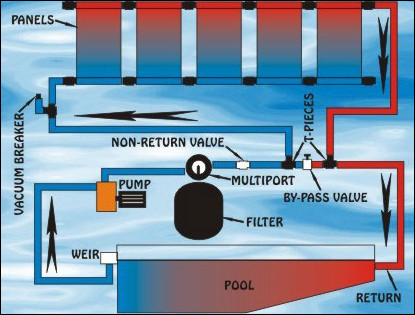Solar Energy Panels
A solar panel (also solar module, photovoltaic module or photovoltaic panel) is a packaged, connected assembly of photovoltaic cells. The solar panel can be used as a component of a larger photovoltaic system to generate and supply electricity in commercial and residential applications. Each panel is rated by its DC output power under standard test conditions, and typically ranges from 100 to 450 watts. The efficiency of a panel determines the area of a panel given the same rated output - an 8% efficient 230 watt panel will have twice the area of a 16% efficient 230 watt panel. Because a single solar panel can produce only a limited amount of power, most installations contain multiple panels. A photovoltaic system typically includes an array of solar panels, an inverter, and sometimes a battery and or solar tracker and interconnection wiring.
Solar Water Heating Systems
Solar water heating (SWH) or solar hot water (SHW) or Solar Geysers systems comprise several innovations and many mature renewable energy technologies that have been well established for many years.
In a "close-coupled" SWH system the storage tank is horizontally mounted immediately above the solar collectors on the roof. No pumping is required as the hot water naturally rises into the tank through thermosiphon flow. In a "pump-circulated" system the storage tank is ground- or floor-mounted and is below the level of the collectors; a circulating pump moves water or heat transfer fluid between the tank and the collectors.
SWH systems are designed to deliver hot water for most of the year. However, in winter there sometimes may not be sufficient solar heat gain to deliver sufficient hot water. In this case a gas or electric booster is normally used to heat the water. (Solar Geysers)
Solar Inverters
A solar inverter, or PV inverter, converts the variable direct current output of a photovoltaic (PV) solar panel into a utility frequency alternating current that can be fed into a commercial electrical grid or used by a local, off-grid electrical network. It is a critical component in a photovoltaic system, allowing the use of ordinary commercial appliances. Solar inverters have special functions adapted for use with photovoltaic arrays, including maximum power point tracking and anti-islanding protection.
Maximum Power Point Tracking (MPPT's)
Maximum power point tracking is a technique that solar inverters use to get the maximum possible power from the PV array. Solar cells have a complex relationship between solar irradiation, temperature and total resistance that produces a non-linear output efficiency known as the I-V curve. It is the purpose of the MPPT system to sample the output of the cells and apply a resistance (load) to obtain maximum power for any given environmental conditions. Essentially, this defines the current that the inverter should draw from the PV in order to get the maximum possible power (since power equals voltage times current).
Solar Batteries
Solar storage batteries are an essential component of any home or commercial solar power system. They store electricity generated by solar panels or wind turbines for periods when there isn’t sufficient sun or wind to generate electricity for immediate use. These can be purchased as part of one of our solar power kits or on their own should you require a replacement for your current system.

How Solar Pool Heating Works

